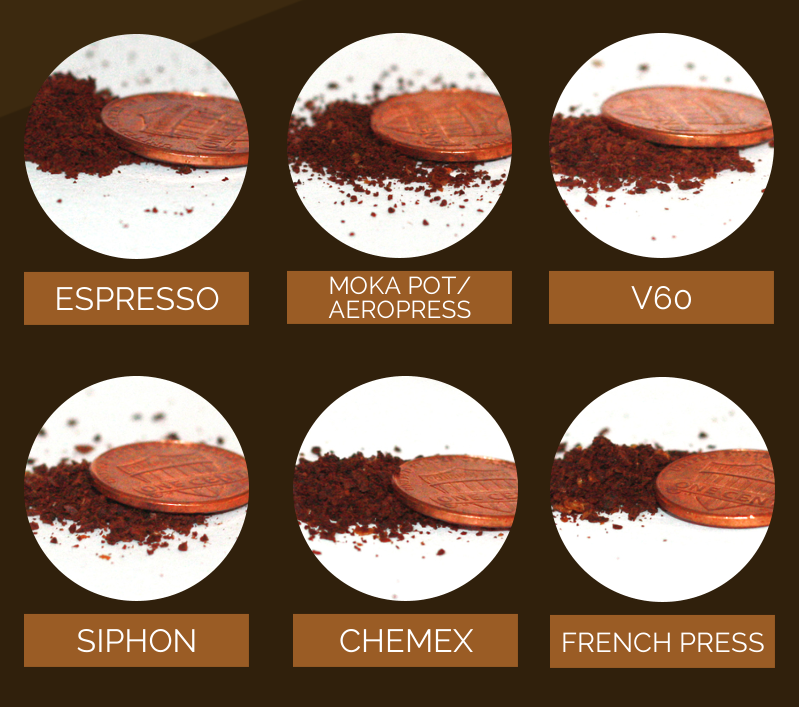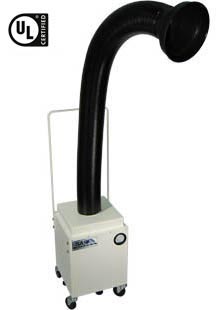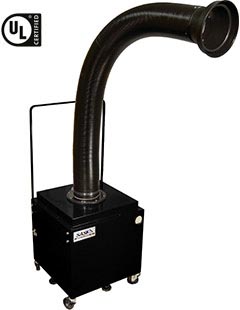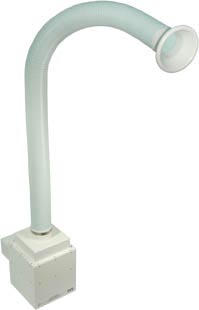
According to a publication from the World Health Organization, dust is considered to be a solid particle ranging in size from below 1 µm (micrometer or micron) up to at least 100 µm, which may become airborne, depending on origin, physical characteristics and ambient conditions.
Below is a reference chart comparing the size of common particles.
Particle |
Particle Size (microns) |
Eye of a Needle |
1,230 |
Beach Sand |
100 – 10,000 |
Pollens |
10 – 1,000 |
Grain Dusts |
5 – 1,000 |
Human Hair |
40 – 300 |
Tea Dust |
8 – 300 |
Coffee |
5 – 400 |
As you can see, the particle size of coffee ranges anywhere from 5 to 400 microns. This is due in part by the type of grind the coffee bean undergoes. The below graphic shows the visual difference between fine and coarse grinds.
Source: www.coffeekind.com
Airborne Dust vs. Respirable Dust
Just because dust is airborne, does not necessarily mean that it may be respirable. Airborne dust is usually considered 100 microns or less in diameter and can enter the nose and mouth during normal breathing. In most cases, the human body can remove the dust through sneezing or coughing.
In contrast, respirable dust measures at less than 5 microns in diameter and should be considered hazardous because it can enter the respiratory tract and deposit on the lungs.
Dust (respirable nuisance) Exposure Limits and Health Effects
Because of the health hazards of respirable dust, regulatory agencies have established occupational exposure limits to these micro-sized particles. The chart below outlines such regulations.
Agency |
Limit Values |
Health Factors |
OSHA Permissible Exposure Limit (PEL) – General Industry |
5 mg/m3 TWA |
Lung disease |
ACGIH |
3 mg/m3 (respirable particles) |
Lung disease with compromised airway clearance |
CAL/OSHA PEL |
5 mg/m3 TWA |
|
TWA – Time Weighted Average, total exposure over the course of an 8 hour work period. |
||
Considering that finely ground coffee powders and dust can measure as small as 5 microns in diameter, they should be considered a hazardous, respirable dust and inhalation should be avoided.
Respiratory effects, studied
 A 2011 research article published by BMC Pulmonary Medicine entitled “Dust exposure and chronic respiratory symptoms among coffee curing workers in Kilimanjaro: a cross sectional study” found that total personal dust exposure among coffee factory workers was higher than those in a control group.
A 2011 research article published by BMC Pulmonary Medicine entitled “Dust exposure and chronic respiratory symptoms among coffee curing workers in Kilimanjaro: a cross sectional study” found that total personal dust exposure among coffee factory workers was higher than those in a control group.
Subsequently, the workers in the coffee factory reported a higher prevalence of chronic respiratory symptoms than did those in the control group (see table).
Table 3 Prevalence of chronic respiratory symptoms among 79 coffee workers and 71 controls (Excerpt from Sakwari, BMC Pulmonary Medicine study)
|
Symptom |
|
Coffee workers n(%) |
Controls n(%) |
p |
| Morning cough | AllNon smokersa | 22(27.8)15(26.8) | 14(19.7)11(18.0) | 0.260.28 |
| Cough day and night | AllNon smokers | 38(48.1)30(53.6) | 29(40.8)22(36.1) | 0.410.07 |
| Cough 4-6 days a week | AllNon smokers | 24(30.4)19(33.9) | 12(16.9)9(14.8) | 0.060.02 |
| Cough more days in 3 months | AllNon smokers | 7(8.9)7(12.5) | 3(4.2)1(1.6) | 0.33b0.03b |
| Morning cough with sputum | AllNon smokers | 18(22.8)13(23.2) | 7(9.9)7(11.5) | 0.050.14 |
| Cough day and night with sputum | AllNon smokers | 19(24.1)17(30.4) | 11(15.5)8(13.1) | 0.220.03 |
| Cough 4-6 days a week with sputum | AllNon smokers | 12(15.2)10(17.9) | 4(5.6)2(3.3) | 0.07b0.01b |
| Cough more day in 3 months sputum | AllNon smokers | 6(7.6)6(10.7) | 1(1.4)0 | n.an.a |
| Dyspnoea I | AllNon smokers | 14(17.7)21(21.4) | 6(8.5)5(8.2) | 0.150.06 |
| Dyspnoea II | AllNon smokers | 11(13.9)10(17.9) | 6(8.5)5(8.2) | 0.320.17 |
| Wheezing | AllNon smokers | 18(22.8)15(26.8) | 18(25.4)11(18.0) | 0.850.28 |
| Chest tightness | AllNon smokers | 21(26.6)20(35.7) | 9(12.7)7(11.5) | 0.040.002 |
Differences between coffee workers and controls are tested by Pearson Chi-square Testa Non smokers comprise 56 coffee workers and 61 controls
b Fischer’s exact test. n.a – Not analyzed
Based on the results, the study concluded that workers exposed to coffee dust had more respiratory symptoms than did those in the control group. Although this was a cross-sectional study and a causal relationship should not be concluded, the results show that there seems to be a relationship between coffee dust exposure and respiratory symptoms.
Dust control and extraction
 Common sources of exposure to coffee dust occur at the production factory during the bean grinding process or in the laboratory where various experiments and tests are performed.
Common sources of exposure to coffee dust occur at the production factory during the bean grinding process or in the laboratory where various experiments and tests are performed.
For the sake of this particular blog post, we will focus on methods for controlling coffee dust in a lab setting.
A popular option is a portable floor dust extractor with flex hose.
This allows the operator to position the extractor exactly where it is needed while the semi-self supportive flex hose creates “hands free” operation.
We offer four series of portable extractors suitable for this application depending on the amount of air volume required.
- SS-200-FS
- Up to 100 CFM
 Model 300 Portable Floor Sentry
Model 300 Portable Floor Sentry
- SS-300-PFS
- Up to 350 CFM
 Model 400 Portable Floor Sentry
Model 400 Portable Floor Sentry
- SS-400-PFS
- Up to 700 CFM
Model 450 Portable Floor Sentry
- SS-450-PFS
- Up to 950 CFM
Caption: Model 400 Portable Fume Extractor w/ Dual Flex Arms for Fine Powder & Dust Containment Application
The 300/400/450 Models are available with dual and quad flex arms configurations for multi-operator use.
In addition to our portable floor units we offer a variety of bench and tabletop systems.
HEPA Filtration
 No matter the configuration, the most important part of the system is the filter chamber. Since the human eye can only see particles about 40 microns and larger without magnification, it is vital to use only high quality HEPA filters to ensure that the coffee dust particles are captured.
No matter the configuration, the most important part of the system is the filter chamber. Since the human eye can only see particles about 40 microns and larger without magnification, it is vital to use only high quality HEPA filters to ensure that the coffee dust particles are captured.
All of our units come equipped with a high quality HEPA filter that is capable of 99.97% efficiency on particles 0.3 microns and larger. That means that respirable particles are arrested at the source of emission before they can travel into the operator’s breathing zone.
Contact Us
For more information about controlling respirable dust and particulate, contact Sentry Air Systems at 800.799.4609, email sales@sentryair.com, visit our website or fill out the feedback form below.
Resources
- World Health Organization: Hazard Prevention and Control in the Work Environment – Airborne Dust
- The Engineering Toolbox – Particle Size
- Sakwari et al.: Dust exposure and chronic respiratory symptoms among coffee curing workers in Kilimanjaro: a cross sectional study. BMC Pulmonary Medicine 2011 11:54.

 Made in the USA
Made in the USA
 Model 200 Floor Sentry
Model 200 Floor Sentry